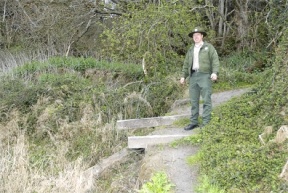FREELAND — It could be a long while before hikers can freely enjoy the beach again at South Whidbey State Park.
Park officials said last week they don’t know when the beach will be reopened after a federal grant they thought would pay for repairs was spent on disaster relief in California. The closure will mark the second summer the popular stretch of sand along Admiralty Inlet will be closed.
A longtime draw to residents and tourists alike, the trail to the beach was closed for safety reasons because of damage from a winter storm in December 2006. Erosion wiped out a part of the stairway that descends down a cliff to the beach.
“We’re starting to get pressure from the public, which we knew we would,” said Terry Doran, the Northwest Region manager for Washington State Parks.
“We’re kind of stymied right now,” he added. “First of all, we don’t have any money. We were counting on the Federal Emergency Management Agency money.”
State Parks has been talking about installing a tower-bridge system that will let visitors get safely down to the beach.
Under the plan, a tower with a staircase would be constructed on the beach. An expandable or retractable bridge would then cross to the bluff.
But that will cost money that the park does not have.
“Now we don’t have a bridge or a set of stairs nor the money to replace it, even if we had a design that we felt comfortable with,” Doran said.
“We are asking for the public’s patience until we get this fixed,” he said.
For Doran, the goal for any beach access structure that is repaired or constructed is for it to last through a rough winter season.
“We hope to build something away from the bank, if it wasn’t attached directly to the side,” he said.
“Then the hillside could erode a little bit, inside of these stairs. Weighing all of the elements of this potential project, getting people onto that beach in a safe and predictable way that won’t disappear next winter — that is a higher priority than the aesthetics at this point. I would like to see a design that gets people to the beach,” he said.
The trail to the beach is a favorite for hundreds of thousands of park visitors throughout the year, said Park Ranger Jon Crimmins. The state park has 4,500 feet of saltwater shoreline on Admiralty Inlet and tidelands for crabbing and clamming.
Approximately 200,000 visitors, campers and day-users come to the 357-acre state park on a yearly basis.
The trail to the beach is currently posted with a sign warning of the dangers at the trailhead and another sign blocking the path before the dangerous section. Even so, Crimmins still finds people down on the beach.
Often times, once they get onto the beach, they pass large trees that lost footing in the clay and sand on the hill.
It is not the trees that fell that endanger the people, but the eroding hill, he said.
“It has always been a problem with this trail,” Crimmins said. “There is deep erosion on the side of the hill and it erodes more each year. It’s always going to be sloughing off.”
The stairs on the last 40 feet of the trail that lead down to the beach totter as blue clay has washed away from underneath the wooden steps from streams and rain. Railroad ties that once were anchored in dirt now hang precariously in thin air. The trail is a mere 24 inches wide.
The actual staircase is now crooked, too, as the earth has eroded from underneath.
“With vegetation, the hills will stabilize themselves,” he said. “But removal of trees and vegetation leads to additional erosion. It’s a nature thing.”
While scientists study the bluff erosion, Crimmins and others are preparing to cut another path the beach that is less steep and follows a gully.
“We understand the draw to the beach,” he said. “But we also have more to do in the park in other areas.”
The park hosts 46 camping sites, including four hiker-biker sites, and all are full during the summer, he said. The 3.5 miles of trails through the park are also a big draw.
“We have people who use the trails every single day,” Crimmins said.
Spencer Webster can be reached at 221-5300 or swebster@southwhidbeyrecord.com.



